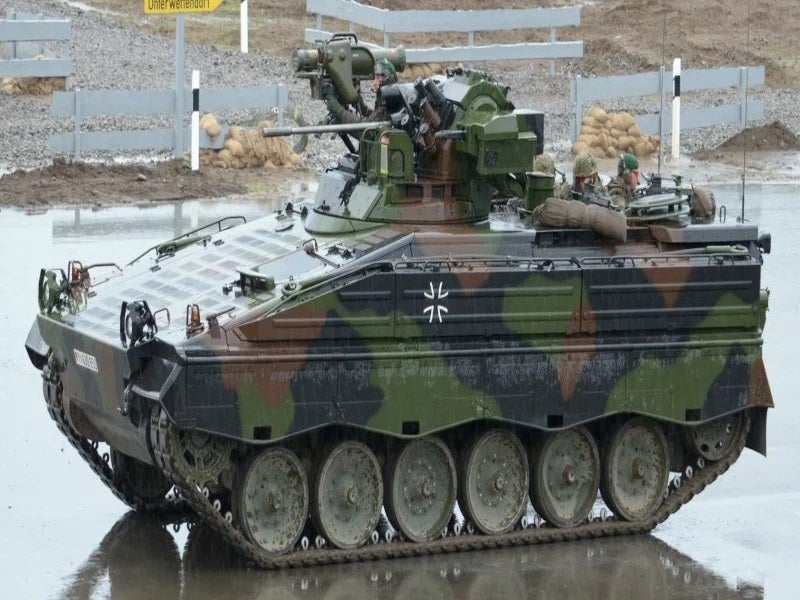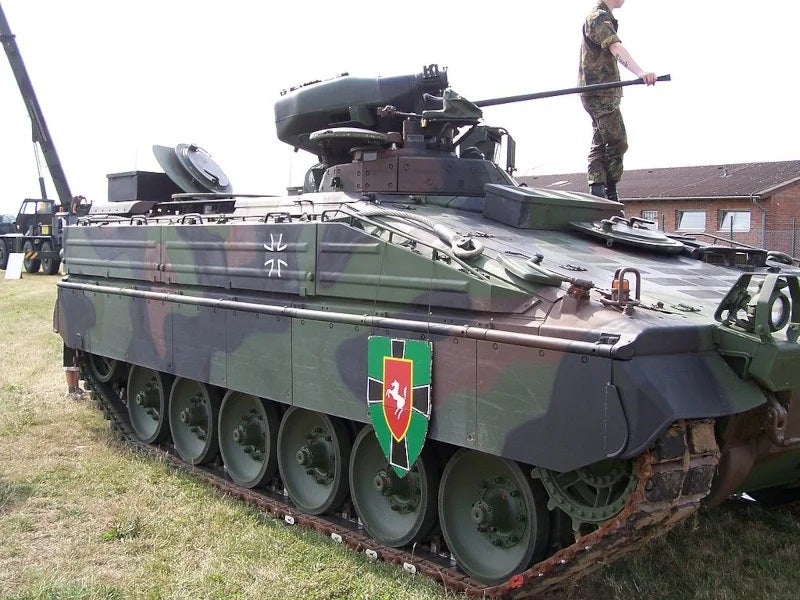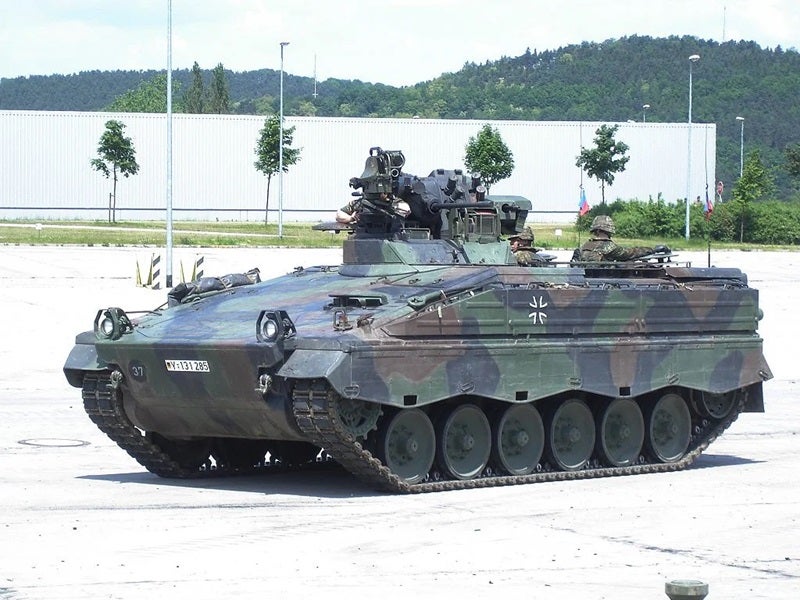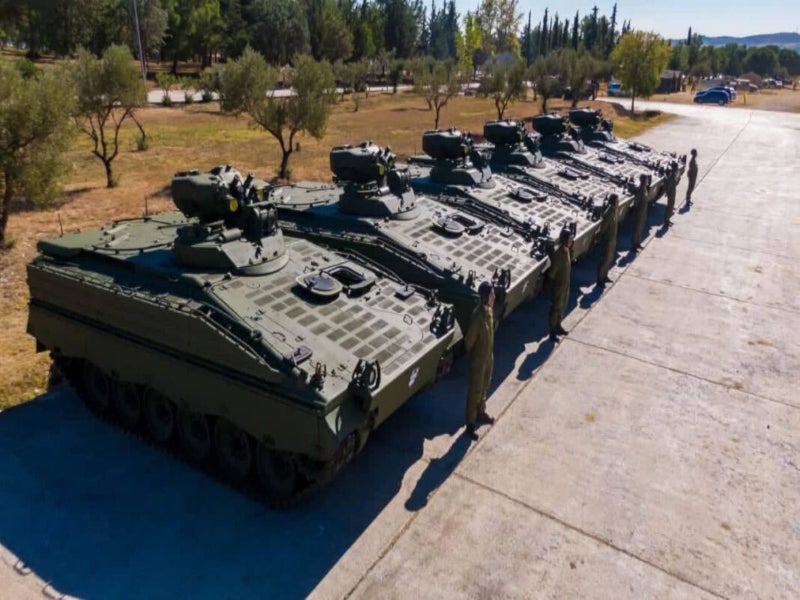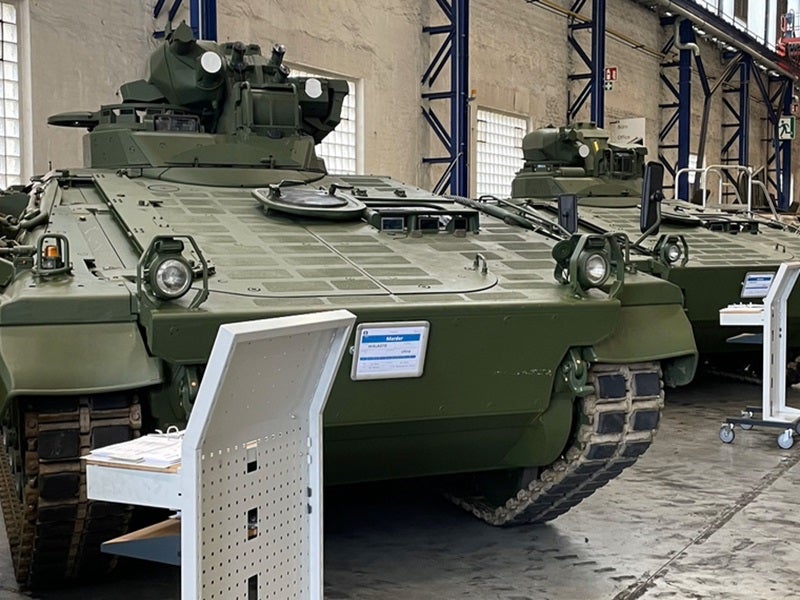The Marder infantry fighting vehicle (IFV) is a tracked armoured vehicle developed by Rheinmetall Landsysteme, a defence company based in Germany.
The Marder IFV was introduced into the Bundeswehr, the federal armed forces of Germany, in May 1971. It received extensive upgrades over the years and remains one of the main weapons of the mechanised infantry units of the German Army, with high-level tactical mobility and firepower, as well as the ability to transport troops in high-risk areas of operation.
The vehicle is also in service with the armed forces of Chile, Jordan, Indonesia and Greece.
The Marder IFV has been battle-tested for more than 50 years in the German military. Although the army has procured 350 Puma IFVs to eventually replace it, the Marder is expected to remain in service for several years to come.
Marder IFV design and features
The Marder IFV has a length of 6.79m, a width of 3.24m, a height of 2.98m, and an overall combat weight of 28.5t. The 1A3 variant weighs 33.5t while the 1A5 and 1A5A1 variants weigh 37.4t and 38.1t, respectively.
The Marder vehicle can accommodate up to three crew members and up to six soldiers in the troop compartment.
It features a powerpack at the front, a turret positioned centrally, and the fighting compartment in the rear section. The vehicle also includes a ramp for the rapid entry and exit of crew and soldiers.
The vehicle is equipped with an SEM 80 primary radio and an SEM 90 secondary radio with a range of 30km for communications.
Marder IFV armour and protection details
The hull and turret armour is made of welded steel. The armour can protect the vehicle and its occupants from up to 20mm armour-piercing discarding sabot (APDS) DM43, and 25mm APDS rounds fired from a distance of 200m.
The sides of the hull are fitted with additional rolled homogenous armour (RHA) shields to provide extra protection.
Observation range in all conditions
The vehicle is equipped with PERI-Z 11 and PERI-Z 11 A1 thermal sight systems for the commander, and PERI-Z 11 and Zeiss thermal imager systems for the gunner.
The ATTICA-GM thermal imager has been integrated into the Marder IFV to assist gunners in performing their missions effectively in challenging weather conditions, replacing the obsolete WBG-X thermal imager.
The vehicle commander has eight periscopes, while the gunner has three periscopes.
The new Saphir 2.6 MK thermal imaging aiming device significantly improves the observation range and round-the-clock reconnaissance quality, due to increased resolution of the detector and advanced display technology.
The new Spectus II night observation device assists the driver in poor visibility by combining an image from a thermal imaging device with one obtained from a residual light amplifier camera. The system also features a rear-view camera.
Weapons system aboard Marder IFV
The Marder IFV is equipped with Milan anti-tank guided missiles, which have highly explosive warheads.
The MELLS multi-role lightweight anti-tank guided missile system, fired by the Marder 1A5 IFV, can engage armoured targets at ranges up to 4,000m. It is expected to replace the Milan missiles onboard the Marder IFVs.
The main armament of the vehicle is the 20mm Rheinmetall MK 20 Rh 202 automatic cannon. The Marder is also equipped with a Rheinmetall MG 3 7.62mm general-purpose machine gun, which has an effective firing range of 200m to 1,200m with sight adjustments. The maximum firing range of the machine gun is up to 3,000m on the gun carriage.
Additionally, the IFV is equipped with a 7.62mm rifle that uses a 7.62mm × 51mm Nato cartridge and has a muzzle velocity of 820m/s.
Propulsion and performance
The Marder IFV is powered by an MTU MB 833 Ea-500 diesel engine. It has a maximum on-road speed of 65km/h and a range of 520km.
The vehicle has a ground clearance of 0.45m, can climb vertical steps of 1m, and can negotiate a gradient of 60% and a side slope of 30%. It can cross a trench of up to 2.5m wide and ford water up to 2m deep.
Battle management system integration
The Marder IFV was upgraded to the Marder 1A1 standard between 1979 and 1982. The upgrade included the installation of a first-generation night-vision device (residual light intensifier) with a thermal energy receiver, and a double belt feeder for the automatic cannon, among other improvements.
A total of 1,462 vehicles were retrofitted with thermal imaging devices (WBG-X) for the gunner, as part of the upgrade to the Marder1A2 standard between 1984 and 1989. The MILAN infrared adapter MIRA was introduced for the MILAN weapon system, and the rear weapon mount was removed. Other enhancements included an upgrade to SEM 80/90 radio and the introduction of spotted camouflage painting.
The Marder 1A3 IFV features additional armour for the turret and hull to protect against 30mm automatic cannon fire, along with a redesigned magazine and ammunition feed. The upgrade also included an extension of the turret machine gun from the weapon housing on the left-hand side of the turret. A total of 2,097 vehicles were upgraded to the Marder 1A3 standard between 1989 and 1998.
The upgrade programme to the Marder 1A4 version saw the utilisation of the version as a mobile command post, equipping 24 vehicles with SEM93 radio.
Marder 1A5 upgrades
The Marder 1A5 upgrade included the addition of extra anti-mine armour to provide protection against blast and projectile-forming mines. The upgrades were performed on 74 Marder 1A3 vehicles between 2002 and 2005.
The interior of the vehicle was remodelled to withstand blasts and protect the crew from shock when hit by a mine. The measures included an altered stowage concept, additional floor clearance in the fighting compartment, the installation of a global positioning system (GPS), a precision lightweight GPS receiver, stronger brakes, and improved ventilation pumps. New steel armour skirts were added, and conical compression springs were replaced with hydraulic buffers.
Rheinmetall retrofitted 35 vehicles to the Marder 1 A5A1 configuration between 2010 and 2011. Enhancements included the installation of air conditioning, multi-spectral camouflage equipment (MMT), and the CG-12 electronic protection system. This version also provided reinforced protection on the fighting compartment roof around the hatches.
Service life extension programme
The decision to start a programme to extend the service life of the German Marder armoured vehicles was made in 2016.
The service life extension measures are intended to remove known obsolescent features of the vehicle. The development and pilot integration of the MELLS missile system into the Marder 1A5 IFV began in 2016, while the deliveries of the retrofit kits for the missile system started in 2017.
Development and pilot retrofitting of a new fire detection and suppression system and a new driver vision system for the Marder 1A3 family also started in 2017. Additionally, the pilot programme for the integration of a battle management system into the different Marder variants began in 2019.
Deliveries of kits for retrofitting fire detection and extinguisher systems into the vehicles commenced in 2019.
International orders and deliveries of Marder IFVs
Rheinmetall received a contract to study ways of integrating the MELLS missile into the Bundeswehr’s Marder IFV in 2016. The company completed the integration of the missile system into 35 Marder 1A5 vehicles by March 2018.
Bundeswehr provided a €110m ($121.9m) contract to Rheinmetall to extend the service life of Marder IFV in December 2019. The agreement aims to maintain and enhance the vehicle’s capabilities, with Rheinmetall supplying 78 conversion kits, including seven spare kits. These kits are used to replace the drivetrain of 71 Marder 1A5 vehicles by installing a new powerpack, which will significantly enhance the vehicle’s responsiveness and boost the engine output from 600hp to more than 750hp.
Rheinmetall was contracted to supply the Bundeswehr with more than 170 Spectus II driver night observation devices for the Marder fleet in October 2020. Deliveries of the Spectus II kits started in 2021.
The Bundeswehr also placed an order with the company in November 2020 to supply 260 Saphir 2.6 MK thermal imaging aiming devices and associated accessories to replace the obsolete devices used for reconnaissance and target engagement. Deliveries of the Saphir 2.6 MK devices commenced in 2021.
Greece received six Marder 1A3 vehicles for the Hellenic Armed Forces in October 2022. The procurement was part of a swap deal with Germany, wherein Greece transferred 40 BMP-1 armoured vehicles to Ukraine in exchange for 40 German Marder 1A3 IFVs.
Rheinmetall delivered the first of 20 Marder IFVs to Ukraine in March 2023. Ukraine later received an additional 20 of these vehicles directly from Bundeswehr’s existing inventory.
In August 2023, Rheinmetall secured a contract to deliver an additional 40 Marder IFVs to Ukraine, increasing the total number of Marder vehicles the company will provide to Ukraine to 80.
Rheinmetall secured a contract from the German Government to supply Ukraine with 20 more Marder IFVs in March 2024. This new lot is scheduled for delivery in 2024.

